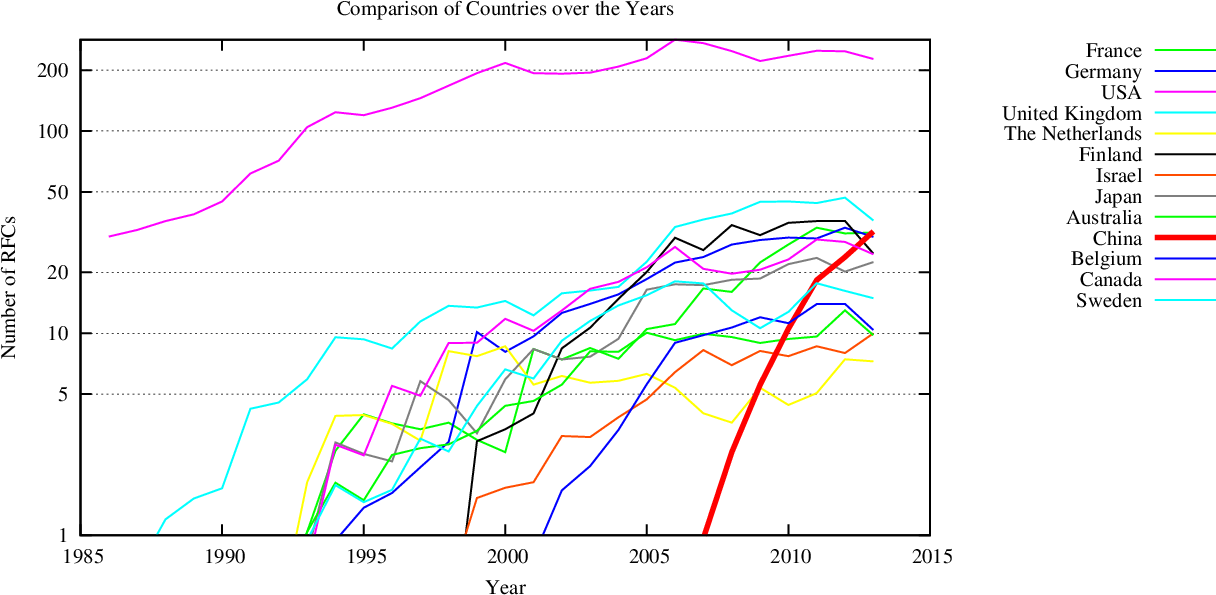Filter by topic and date
China
- Jari Arkko IETF Chair
19 Sep 2013
Last week I toured China, talking to the local IETF contributors. And there are so many! I talked to people from equipment vendors, operators, researcher institutions, and local standards organisations.

I talked to people from equipment vendors, operators, researcher institutions, and local standards organisations. We have said that we want to increase the participation of all parts of the world at IETF work. China’s rise is definitely a success story for others to follow: many new RFCs today have authors from China (soon 2nd after US), Chinese contributors have roles in the IETF as working group chairs or IAB members, we’ve held a meeting in Beijing (hosted by Tsinghua), and our next meeting has a host from China (Huawei). And of course, the growth trend is not accidental, but has come about due to the large importance of networking for the industry everywhere, moving telecommunications on top of IP, and various industry trends.
Some of the things that came up relate to detailed issues in getting a particular proposal moving forward, others were at a higher level, pointing to the need to further develop some aspect of the Internet. The most common topics on last week’s trip were:
- IPv6 – this continues to be a high priority topic. In many cases the deployment effort is more practical effort than further development of standards, of course. But address space expansion is particularly important for China’s large population, and I think we can expect large efforts on this. Just as an example, China Telecom plans to enroll 3 million subscribers to its IPv6-based broadband network by the end of the year. Exciting times ahead, and that is just a tiny fraction of the population!
- Internet of Things draws a lot of attention from developers, and it is clear that further standards work is needed there in areas such as security, energy consumption, and group communication.
- Managing the time-to-market delay for standardized solutions. BOF-to-RFC time has been one of the problems that I have identified, but the overall time-to-market for new technology is a critical issue for many participants. One of the approach that I think will help this is also our recent trend in producing frameworks that are programmable for specific applications, rather than protocols that have all features built in. For instance, the Web of Things and WebRTC will help developers come up with applications quickly, as soon as the fundamental framework is in place.
- By the way, the WebRTC project is a joint effort between the IETF and W3C. We often see this with new technologies, co-operation with different organisations is necessary. Such co-operation was a topic on my visit to China as well, for instance, the China Communications Security Association depends on many IETF technologies, and information sharing to understand what different parties are doing is important.
- Software Defined Networking. This is a hot topic in several standards organisations. At the IETF, we have one working group and one research group – I’m sure there will be more work in this space in the future, as the industry learns how we can use this technology.
- The role of Future Internet research vs. the IETF. I think research on this topic has been very interesting. My favourite result from this work is Information Centric Networking (ICN). We have a research group at the IRTF where this technology can be discussed. When and if there are results that we can take for production use, I at least would be happy to host working groups at the IETF. I do believe, however, that deployment of new technology is a challenge and as a result, incremental deployment models for ICN may be the most useful ones.
But, of course, there is plenty of work left. My trip to China was just a part of an overall effort to try to understand what various people need from the IETF. I would be very happy to receive feedback on what the IETF is doing, how it is doing it, and Internet technology at any time. For instance, what does networking need in South America or Africa, two areas that have a growing attendance in the IETF but are not yet so visible in the RFC publication graph? Also, if there is a problem in the IETF process somewhere, I would be happy to know and try to improve.
Feel free to contact me and let me know what is on your mind!